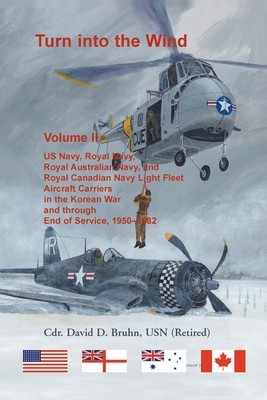
- We will send in 10–14 business days.
- Author: David Bruhn
- Publisher: Heritage Books
- ISBN-10: 0788408690
- ISBN-13: 9780788408694
- Format: 15.2 x 22.9 x 1.8 cm, softcover
- Language: English
- SAVE -10% with code: EXTRA
Turn into the Wind, Volume II. US Navy, Royal Navy, Royal Australian Navy, and Royal Canadian Navy Light Fleet Aircraft Carriers in the Korean War and through end of service, 1950-1982 (e-book) (used book) | bookbook.eu
Reviews
Description
American and British light fleet aircraft carriers, an expedient of war at a time of dire need in World War II, answered their nations' call a second time during the Korean War. While larger US Navy fleet carriers plied their trade in the deeper Sea of Japan off Korea's east coast, their svelte sisters - USS Bataan, HMS Glory, HMS Ocean, HMS Theseus, HMS Triumph, and HMAS Sydney - were consigned to the Yellow Sea. Operating off the west coast, ragged and heavily indented with numerous small islands, aircraft aboard the carriers repeatedly struck the enemy. Winters were cold, with occasional gales and blinding snow squalls; summers were hot and humid, with heavy rains and fog. While the piston-engine aircraft attacked enemy supply lines, fortifications, and troop positions, enemy MiG jet aircraft were a constant threat, some flown by Russians. Carrier air also provided protection to friendly islands, from which guerillas mounted operations behind enemy lines. Following the Korean War, Australia acquired two additional former Royal Navy light fleet carriers, and Canada three in succession, as centerpieces for naval fixed air programs. Former CVLs served in new roles during the Cold War/Vietnam War: USS Wright as a "doomsday" afloat White House, HMAS Sydney as a troop transport, and USS Arlington as a communications link between the Pentagon and commanders in the field. One hundred fifty-five photographs, maps, and diagrams; appendices; and an index to full-names, places, and subjects add value to this work.
2021, 6x9, paper, index, 326 pp
EXTRA 10 % discount with code: EXTRA
The promotion ends in 18d.20:29:25
The discount code is valid when purchasing from 10 €. Discounts do not stack.
- Author: David Bruhn
- Publisher: Heritage Books
- ISBN-10: 0788408690
- ISBN-13: 9780788408694
- Format: 15.2 x 22.9 x 1.8 cm, softcover
- Language: English English
American and British light fleet aircraft carriers, an expedient of war at a time of dire need in World War II, answered their nations' call a second time during the Korean War. While larger US Navy fleet carriers plied their trade in the deeper Sea of Japan off Korea's east coast, their svelte sisters - USS Bataan, HMS Glory, HMS Ocean, HMS Theseus, HMS Triumph, and HMAS Sydney - were consigned to the Yellow Sea. Operating off the west coast, ragged and heavily indented with numerous small islands, aircraft aboard the carriers repeatedly struck the enemy. Winters were cold, with occasional gales and blinding snow squalls; summers were hot and humid, with heavy rains and fog. While the piston-engine aircraft attacked enemy supply lines, fortifications, and troop positions, enemy MiG jet aircraft were a constant threat, some flown by Russians. Carrier air also provided protection to friendly islands, from which guerillas mounted operations behind enemy lines. Following the Korean War, Australia acquired two additional former Royal Navy light fleet carriers, and Canada three in succession, as centerpieces for naval fixed air programs. Former CVLs served in new roles during the Cold War/Vietnam War: USS Wright as a "doomsday" afloat White House, HMAS Sydney as a troop transport, and USS Arlington as a communications link between the Pentagon and commanders in the field. One hundred fifty-five photographs, maps, and diagrams; appendices; and an index to full-names, places, and subjects add value to this work.
2021, 6x9, paper, index, 326 pp


Reviews